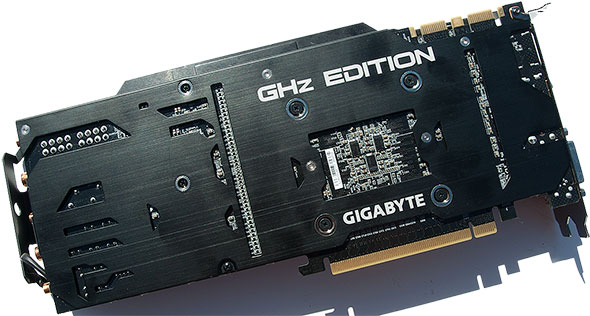GeForce GTX 780 Ti Round Up: EVGA, Gigabyte, MSI
Gigabyte Windforce 3X GHz Edition
Gigabyte's robust stable of graphics cards includes four separate GeForce GTX 780 Ti models, none faster than the one reviewed here (GV-N78TGHZ-3GD). The reason Gigabyte feels comfortable pushing the clockspeeds so high is because of its new Windforce 3X dual-slot 450W cooling solution.


A brushed metal plate reinforces three inclined fans, affixed to a pair of large finned heat sinks. There are two 8mm and four 6mm copper heat pipes running through the cooling system, and underneath it all is a metal plate that serves as a heat sink for the onboard GDDR5 memory.
Each of the three PWN fans has 11 blades. They're clipped to the fins of the heatsink and positioned at a slight angle to reduce turbulence and increase the efficiency of heat transfer. Because everything needs a marketing term these days, Gigabyte calls this "Triangle Cool" technology.
We call it a massive cooling solution. All three 780 Ti cards in this roundup are large, though Gigabyte's is the biggest at 292mm (L) by 129mm (W) by 43mm (H).

Each of the three PWN fans has 11 blades. They're clipped to the fins of the heatsink and positioned at a slight angle to reduce turbulence and increase the efficiency of heat transfer. Because everything needs a marketing term these days, Gigabyte calls this "Triangle Cool" technology.
We call it a massive cooling solution. All three 780 Ti cards in this roundup are large, though Gigabyte's is the biggest at 292mm (L) by 129mm (W) by 43mm (H).

A reinforced backplate with side panel adds to the card's heft, ruggedness, and cooling potential. It also features a brushed metal motif along with the "GHz Edition" tag
As for the PCB it's designed to protect, Gigabyte went with an 8-phase power design compared to NVIDIA's reference 6-phase design. Gigabyte says this allows the MOSFETs to work at a lower temperature and provide more stable voltage output. In theory, this should extend the life of the graphics card too.

As for the PCB it's designed to protect, Gigabyte went with an 8-phase power design compared to NVIDIA's reference 6-phase design. Gigabyte says this allows the MOSFETs to work at a lower temperature and provide more stable voltage output. In theory, this should extend the life of the graphics card too.

You'll need to a pair of 8-pin PCI-E connectors to power the card. If you're short on these but own a power supply that's capable of running a 780 Ti, you won't need to rush out and buy a new PSU, as Gigabyte includes a pair of Molex to 8-pin adapters.


Gigabyte's OC Guru II software provides a GUI frontend for the 780 Ti's vitals, including clockspeeds, fan speeds, power consumption, and several other tidbits. You can also use the software to overclock the card even further, or to dial back clockspeeds if a particular game is causing the card to crash.






